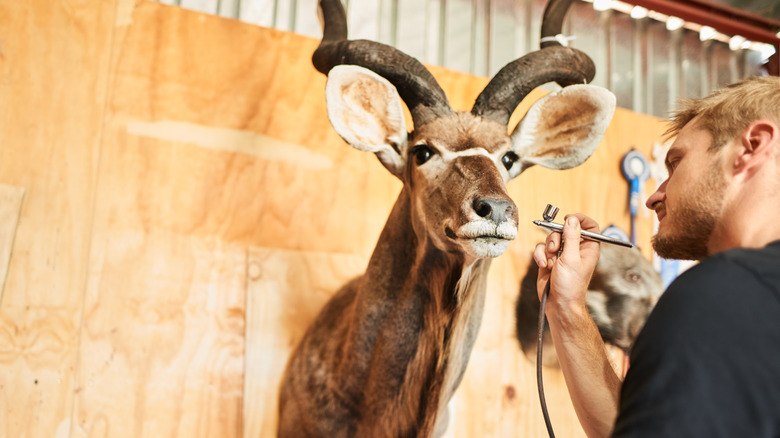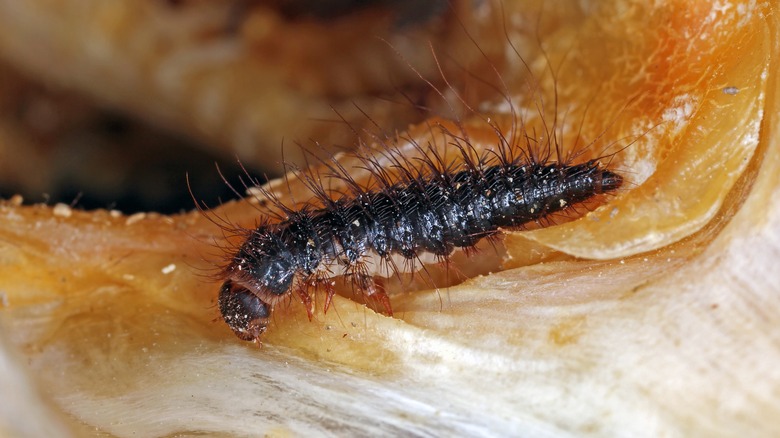The Taxidermy In Your Home Could Be Hiding A Sneaky Pest Control Problem
We may receive a commission on purchases made from links.
Somewhere in the back of the minds of everyone who owns a beloved pet is the realization that one day they're going to have to say goodbye forever. The grief pushes some people to preserve the animal's body in the form of taxidermy. Similarly, hunters who want to immortalize their trophies are in the same boat. Unfortunately, this comes at great risk because those taxidermy hides can harbor some sneaky critters without your knowledge. Dermestid beetles, clothes moths, and roaches are all potential pests that could be attracted to your home, thanks to the taxidermied animal.
Taxidermy is the process of preserving animal flesh, often chemically and propped up on a sort of plastic mannequin to hold the shape. Some taxidermists also freeze-dry the bodies. Regardless of all this processing, there are some insects that will still try to scavenge on the taxidermy. When a taxidermied animal becomes infested with pests, you can usually tell by examining the floor underneath it. Check for frass, or dust particulars, and even shed hair. As the pests feed on the hide, this debris trickles down to the floor. This can be a major bummer for owners, but you can minimize the damage without resorting to fumigation and also take steps to keep insects out of your house.
Choosing the best method to get rid of taxidermy pests
Moths and dermestid beetles find their way inside your home from open windows and doors and then lay their eggs on the mounted hide. If there's one thing larvae love to gorge themselves on, it's hair, be it human hair, woolen clumps of fabric, or fur from your taxidermy. As the larvae feed on the hide and grow to become adults, they will begin to lay their own eggs in exposed areas, like your carpet or closet where clothes are. Like a domino effect, your whole house can become infested.
Contrary to what you may think, however, not all pests you find on your taxidermy are there to devour it. The presence of some species of bugs could be a result of the condition of the taxidermy itself. If you live in an environment with high relative humidity, your taxidermy could stand the risk of getting damp and even developing mold and mildew. Insects like woodlice are drawn to this moisture content which keeps their bodies hydrated for fear of drying out. They also eat fungi, which would naturally occur on a damp taxidermied animal.
Treat the taxidermy and prevent pests from getting near it
If you notice that your taxidermy has a pest infestation, there are a few ways to put an end to it. At the risk of giving off serial killer vibes, you can stash the body in your deep freezer. Wrap it up and leave it there for at least a couple of weeks so that the insects and their eggs will die off. Additionally, you can use a pest strip. Put the taxidermy in a plastic bag, throw in a Hot Shot No-Pest strip ($10 on Amazon), and tie it up nice and airtight. To keep these pests off your property to begin with, always ensure your windows are closed and cracks in the doorways and entrances are sealed.
Maintaining the area around your taxidermy is a good way to combat pests nestling in it and razing down the hairs and skin. Oftentimes, some of these pests, such as carpet beetles and dermestid beetles, disperse around your house and occupy your food and floors. For carpets and rugs, vacuum up any crumbs of food or debris that you see and get rid of the trash bag inside the machine so that the pests won't escape. If you find a large number of beetles in your food containers, dispose of the food. If it's a manageable amount, you can sift out the insects, or heat up or chill it until they've all been exterminated.


